Time-Series Assessment of Camp-Type Artisanal and Small-Scale Gold Mining Sectors with Large Influxes of Miners Using LANDSAT Imagery
Abstract
:1. Introduction
2. Materials and Methods
2.1. Overall Methodological Workflow
2.2. Study Area
2.3. Satellite Imagery
2.4. Extraction and Calculation of Built-Up Areas
2.5. Investigation of ASGM Camps
3. Results
3.1. Expansion of Built-Up Areas in the Mining Camps
3.2. Investigation of ASGM Camps
3.3. Relationship between the Built-Up Areas and the Gold Price
4. Discussion and Limitations
4.1. Discussion
4.2. Limitations
5. Conclusions
Author Contributions
Funding
Institutional Review Board Statement
Informed Consent Statement
Acknowledgments
Conflicts of Interest
References
- United Nations Environment Programme. Estimating Mercury Use and Documenting Practices in Artisanal and Small-Scale Gold Mining (ASGM); UN Environment: Geneva, Switzerland, 2017. [Google Scholar]
- Lobo, F.D.L.; Costa, M.; Novo, E.M.L.D.M.; Telmer, K. Distribution of Artisanal and Small-Scale Gold Mining in the Tapajós River Basin (Brazilian Amazon) over the Past 40 Years and Relationship with Water Siltation. Remote Sens. 2016, 8, 579. [Google Scholar] [CrossRef] [Green Version]
- Wilson, M.L.; Renne, E.; Roncoli, C.; Agyei-Baffour, P.; Tenkorang, E.Y. Integrated Assessment of Artisanal and Small-Scale Gold Mining in Ghana—Part 3: Social Sciences and Economics. Int. J. Environ. Res. Public Health 2015, 12, 8133–8156. [Google Scholar] [CrossRef] [PubMed] [Green Version]
- World Health Organization. Artisanal and Small-Scale Gold Mining and Health; World Health Organization: Geneva, Switzerland, 2016. [Google Scholar]
- United Nations Environment Programmet. Technical Background Report to the Global Mercury Assessment 2018; United Nations Environment Programme: Tromsø, Norway, 2018. [Google Scholar]
- Isaza, A.S.; Villegas-Palacio, C.; Arango, S. The public good dilemma of a non-renewable common resource: A look at the facts of artisanal gold mining. Resour. Policy 2013, 38, 224–232. [Google Scholar] [CrossRef]
- United Nations Environment Programme. Global Mercury Assessment; United Nations Environment Programme: Geneva, Switzerland, 2018. [Google Scholar]
- Macháček, J. Typology of Environmental Impacts of Artisanal and Small-Scale Mining in African Great Lakes Region. Sustainability 2019, 11, 3027. [Google Scholar] [CrossRef] [Green Version]
- World Bank Group. Poverty Headcount Ratio at National Poverty Lines (% of Population)-Indonesia. Available online: https://data.worldbank.org/indicator/SI.POV.NAHC?locations=ID (accessed on 6 June 2021).
- BALIFOKUS. Mercury Contaminated Sites in ASGM Sites of Indonesia; BALIFOKUS: Bali, Indonesia, 2019. [Google Scholar]
- Ismawati, J.; Petrlik, Y.; DiGangi, J. Mercury Hotspots in Indonesia ASGM Sites: Poboya and Sekotong in Indonesia. Available online: https://ipen.org/hgmonitoring/pdfs/indonesia-report-en.pdf (accessed on 6 June 2021).
- United Nations Environment Programmet. Developing National ASGM Formalization Strategies within National Action Plans; United Nations Environment Programme: Geneva, Switzerland, 2018. [Google Scholar]
- United Nations Environment Programmet. Developing a National Action Plan to Reduce and, Where Feasible, Eliminate Mercury Use in Artisanal and Small-Scale Gold Mining; United Nations Environment Programme: Geneva, Switzerland, 2017. [Google Scholar]
- Hilson, G.; Zolnikov, T.R.; Ortiz, D.R.; Kumah, C. Formalizing artisanal gold mining under the Minamata convention: Previewing the challenge in Sub-Saharan Africa. Environ. Sci. Policy 2018, 85, 123–131. [Google Scholar] [CrossRef]
- Kinyondo, A.; Huggins, C. Promoting environmental sustainability in the artisanal and small-scale mining sector in Tanzania. WIDER Work. Pap. 2021, 119, 1–25. [Google Scholar]
- International Institute for Sustainable Development. Global Trends in Artisanal and Small-Scale Mining (Asm): A Review of Key Numbers and Issues; IISD: Winnipeg, Canada, 2018. [Google Scholar]
- Spiegel, S.J.; Agrawal, S.; Mikha, D.; Vitamerry, K.; Le Billon, P.; Veiga, M.; Konolius, K.; Paul, B. Phasing Out Mercury? Ecological Economics and Indonesia’s Small-Scale Gold Mining Sector. Ecol. Econ. 2018, 144, 1–11. [Google Scholar] [CrossRef]
- Ismawati, Y. ASGM: The Production of Social and Environmental Suffering Gold, mercury and the next Minamata tragedy. Bali Fokus. Denpasar. 2014, 2009, 1–14. [Google Scholar]
- World Gold Council. Gold Prices. Available online: https://www.gold.org/goldhub (accessed on 6 June 2021).
- Asner, G.P.; Llactayo, W.; Tupayachi, R.; Luna, E.R. Elevated rates of gold mining in the Amazon revealed through high-resolution monitoring. Proc. Natl. Acad. Sci. USA 2013, 110, 18454–18459. [Google Scholar] [CrossRef] [Green Version]
- Swenson, J.J.; Carter, C.E.; Domec, J.-C.; Delgado, C.I. Gold Mining in the Peruvian Amazon: Global Prices, Deforestation, and Mercury Imports. PLoS ONE 2011, 6, e18875. [Google Scholar] [CrossRef] [Green Version]
- Macháček, J. Alluvial Artisanal and Small-Scale Mining in a River Stream—Rutsiro Case Study (Rwanda). Forests 2020, 11, 762. [Google Scholar] [CrossRef]
- Kahhat, R.; Parodi, E.; Larrea-Gallegos, G.; Mesta, C.; Vázquez-Rowe, I. Environmental impacts of the life cycle of alluvial gold mining in the Peruvian Amazon rainforest. Sci. Total Environ. 2019, 662, 940–951. [Google Scholar] [CrossRef] [PubMed]
- Nakazawa, K.; Nagafuchi, O.; Kawakami, T.; Inoue, T.; Yokota, K.; Serikawa, Y.; Cyio, B.; Elvince, R. Human health risk assessment of mercury vapor around artisanal small-scale gold mining area, Palu city, Central Sulawesi, Indonesia. Ecotoxicol. Environ. Saf. 2016, 124, 155–162. [Google Scholar] [CrossRef] [PubMed]
- Bose-O’Reilly, S.; Drasch, G.; Beinhoff, C.; Rodrigues-Filho, S.; Roider, G.; Lettmeier, B.; Maydl, A.; Maydl, S.; Siebert, U. Health assessment of artisanal gold miners in Indonesia. Sci. Total Environ. 2010, 408, 713–725. [Google Scholar] [CrossRef]
- Wyatt, L.; Ortiz, E.J.; Feingold, B.; Berky, A.; Diringer, S.; Morales, A.M.; Jurado, E.R.; Hsu-Kim, H.; Pan, W. Spatial, Temporal, and Dietary Variables Associated with Elevated Mercury Exposure in Peruvian Riverine Communities Upstream and Downstream of Artisanal and Small-Scale Gold Mining. Int. J. Environ. Res. Public Health 2017, 14, 1582. [Google Scholar] [CrossRef] [Green Version]
- Schmid, T.; Rico, C.; Rodríguez-Rastrero, M.; Sierra, M.J.; Díaz-Puente, F.J.; Pelayo, M.; Millán, R. Monitoring of the mercury mining site Almadén implementing remote sensing technologies. Environ. Res. 2013, 125, 92–102. [Google Scholar] [CrossRef]
- Espejo, J.C.; Messinger, M.; Román-Dañobeytia, F.; Ascorra, C.; Fernandez, L.E.; Silman, M. Deforestation and Forest Degradation Due to Gold Mining in the Peruvian Amazon: A 34-Year Perspective. Remote Sens. 2018, 10, 1903. [Google Scholar] [CrossRef] [Green Version]
- Emel, J.; Plisinski, J.; Rogan, J. Monitoring geomorphic and hydrologic change at mine sites using satellite imagery: The Geita Gold Mine in Tanzania. Appl. Geogr. 2014, 54, 243–249. [Google Scholar] [CrossRef]
- Puluhulawa, F.; Harun, A.A. Policy formalization of Artisanal and Small-Scale Gold Mining (ASGM) post-ratification of Minamata Convention for Sustainability (case study of ASGM Gorontalo). E3S Web Conf. 2019, 125, 02006. [Google Scholar] [CrossRef]
- Kimijiama, S.; Nagai, M. Study of urbanization corresponding to socio-economic activities in Savannaket, Laos using satellite remote sensing. Malaysisan J. Remote Sens. GIS 2014, 3, 71–75. [Google Scholar]
- Kimijima, S.; Sakakibara, M.; Amin, A.; Nagai, M.; Arifin, Y.I. Mechanism of the Rapid Shrinkage of Limboto Lake in Gorontalo, Indonesia. Sustainability 2020, 12, 9598. [Google Scholar] [CrossRef]
- Alam, A.; Bhat, M.S.; Maheen, M. Using Landsat satellite data for assessing the land use and land cover change in Kashmir valley. GeoJournal 2020, 85, 1529–1543. [Google Scholar] [CrossRef] [Green Version]
- Pericak, A.A.; Thomas, C.J.; Kroodsma, D.A.; Wasson, M.F.; Ross, M.R.; Clinton, N.E.; Campagna, D.J.; Franklin, Y.; Bernhardt, E.S.; Amos, J.F. Mapping the yearly extent of surface coal mining in Central Appalachia using Landsat and Google Earth Engine. PLoS ONE 2018, 13, e0197758. [Google Scholar] [CrossRef] [Green Version]
- Gallwey, J.; Robiati, C.; Coggan, J.; Vogt, D.; Eyre, M. A Sentinel-2 based multispectral convolutional neural network for detecting artisanal small-scale mining in Ghana: Applying deep learning to shallow mining. Remote Sens. Environ. 2020, 248, 111970. [Google Scholar] [CrossRef]
- Owusu-Nimo, F.; Mantey, J.; Nyarko, K.; Appiah-Effah, E.; Aubynn, A. Spatial distribution patterns of illegal artisanal small scale gold mining (Galamsey) operations in Ghana: A focus on the Western Region. Heliyon 2018, 4, e00534. [Google Scholar] [CrossRef] [PubMed] [Green Version]
- Lampost.co. Tambang Liar di Register 20 Gunung Bunder Tak Pernah Berakhir. Available online: https://www.lampost.co/berita-tambang-liar-di-register-20-gunung-bunder-tak-pernah-berakhir.html (accessed on 10 July 2021).
- Hatu, R.A. Socio-economic Conditions in The Illegal Gold Miners Tulabolo Village, Gorontalo-in Indonesian. Asian J. Appl. Sci. 2016, 9, 97–105. [Google Scholar] [CrossRef] [Green Version]
- PT Bumi Resources Minerals Tbk. Laporan Tahunan 2019 Annual Report; PT Bumi Resources Minerals Tbk: Jakarta, Indonesia, 2019. [Google Scholar]
- Van Bemmelen, R.W. The Geology of Indonesia. General Geology of Indonesia and Adjacent Archipelagoes; Government Printing Office: The Hague, The Netherlands, 1949; pp. 545–547, 561–562.
- Kesatuan Pengelotaan Hutan. Rencana Pengelolaan Hutan Jangka Panjang Kphp Unit Vii Bone Bo-Lango Tahun 2016–2025; Bone Bolango Regency: Suwawa, Indonesia, 2016. [Google Scholar]
- Kimijima, S.; Nagai, M. Human Mobility Analysis for Extracting Local Interactions under Rapid Socio-Economic Transformation in Dawei, Myanmar. Sustainability 2017, 9, 1598. [Google Scholar] [CrossRef] [Green Version]
- Kawamura, Y.; Jayamana, M.; Tsujiko, S. Relation between social and environmental conditions in colombo sri lanka and the urban index estimated by satellite remote sensing data. Int. Arch. Photogramm. Remote Sens. 1996, 31, 321–326. [Google Scholar]
- Zha, Y.; Gao, J.; Ni, S. Use of normalized difference built-up index in automatically mapping urban areas from TM imagery. Int. J. Remote Sens. 2003, 24, 583–594. [Google Scholar] [CrossRef]
- Xu, H. A new index for delineating built-up land features in satellite imagery. Int. J. Remote Sens. 2008, 29, 4269–4276. [Google Scholar] [CrossRef]
- Bhatti, S.S.; Tripathi, N.K. Built-up area extraction using Landsat 8 OLI imagery. GIScience Remote Sens. 2014, 51, 445–467. [Google Scholar] [CrossRef] [Green Version]
- As-Syakur, A.R.; Adnyana, I.W.S.; Arthana, I.W.; Nuarsa, I.W. Enhanced Built-Up and Bareness Index (EBBI) for Mapping Built-Up and Bare Land in an Urban Area. Remote Sens. 2012, 4, 2957–2970. [Google Scholar] [CrossRef] [Green Version]
- Waqar, M.M.; Mirza, J.F.; Mumtaz, R.; Hussain, E. Development of New Indices for Extraction of Built-Up Area & Bare Soil. Open Access Sci. Rep. 2012, 1, 1–4. [Google Scholar]
- Kaimaris, D.; Patias, P. Identification and Area Measurement of the Built-up Area with the Built-up Index (BUI). Int. J. Adv. Remote Sens. GIS 2016, 5, 1844–1858. [Google Scholar]
- Firozjaei, M.K.; Sedighi, A.; Kiavarz, M.; Qureshi, S.; Haase, D.; Alavipanah, S.K. Automated Built-Up Extraction Index: A New Technique for Mapping Surface Built-Up Areas Using LANDSAT 8 OLI Imagery. Remote Sens. 2019, 11, 1966. [Google Scholar] [CrossRef] [Green Version]
- Villa, P.; Mousivand, A.; Bresciani, M. Aquatic vegetation indices assessment through radiative transfer modeling and linear mixture simulation. Int. J. Appl. Earth Obs. Geoinf. 2014, 30, 113–127. [Google Scholar] [CrossRef]
- Zhou, G.; Ma, Z.; Sathyendranath, S.; Platt, T.; Jiang, C.; Sun, K. Canopy Reflectance Modeling of Aquatic Vegetation for Algorithm Development: Global Sensitivity Analysis. Remote Sens. 2018, 10, 837. [Google Scholar] [CrossRef] [Green Version]
- Jaskuła, J.; Sojka, M. Assessing Spectral Indices for Detecting Vegetative Overgrowth of Reservoirs. Pol. J. Environ. Stud. 2019, 28, 4199–4211. [Google Scholar] [CrossRef]
- Villa, P.; Bresciani, M.; Braga, F.; Bolpagni, R. Comparative Assessment of Broadband Vegetation Indices Over Aquatic Vegetation. IEEE J. Sel. Top. Appl. Earth Obs. Remote Sens. 2014, 7, 3117–3127. [Google Scholar] [CrossRef]
- Japan Association on Remote Sensing. Remote Sensing Note; Japan Association on Remote Sensing: Tokyo, Japan, 1993. [Google Scholar]
- Kogyo, T.K. Gold Price Change. Available online: https://gold.tanaka.co.jp/commodity/souba/m-gold.php (accessed on 11 June 2021).
- Bullion Rates. Gold Price History in Indonesian Rupiahs (IDR). Available online: https://www.bullion-rates.com/ (accessed on 11 June 2021).
- Statistics of Bone Bolango Regency. Bone Bolango Dalam Angka 2010; BPS- Statistics of Bone Bolango Regency: Suwawa, Indonesia, 2010. [Google Scholar]
- Statistics of Bone Bolango Regency. Bone Bolango Dalam Angka 2011; BPS- Statistics of Bone Bolango Regency: Suwawa, Indonesia, 2011. [Google Scholar]
- Statistics of Bone Bolango Regency. Bone Bolango Dalam Angka 2020; BPS- Statistics of Bone Bolango Regency: Suwawa, Indonesia, 2020. [Google Scholar]
- Statistics of Bone Bolango Regency. Bone Bolango Dalam Angka 2012; BPS- Statistics of Bone Bolango Regency: Suwawa, Indonesia, 2012. [Google Scholar]
- Statistics of Bone Bolango Regency. Bone Bolango Dalam Angka 2013; BPS- Statistics of Bone Bolango Regency: Suwawa, Indonesia, 2013. [Google Scholar]
- Statistics of Bone Bolango Regency. Bone Bolango Dalam Angka 2014; BPS- Statistics of Bone Bolango Regency: Suwawa, Indonesia, 2014. [Google Scholar]
- Statistics of Bone Bolango Regency. Bone Bolango Dalam Angka 2015; BPS- Statistics of Bone Bolango Regency: Suwawa, Indonesia, 2015. [Google Scholar]
- Statistics of Bone Bolango Regency. Bone Bolango Dalam Angka 2016; BPS- Statistics of Bone Bolango Regency: Suwawa, Indonesia, 2016. [Google Scholar]
- Statistics of Bone Bolango Regency. Bone Bolango Dalam Angka 2017; BPS- Statistics of Bone Bolango Regency: Suwawa, Indonesia, 2017. [Google Scholar]
- Statistics of Bone Bolango Regency. Bone Bolango Dalam Angka 2018; BPS- Statistics of Bone Bolango Regency: Suwawa, Indonesia, 2018. [Google Scholar]
- Statistics of Bone Bolango Regency. Bone Bolango Dalam Angka 2019; BPS- Statistics of Bone Bolango Regency: Suwawa, Indonesia, 2019. [Google Scholar]
- Sousa, R.N.; Veiga, M.M.; Meech, J.; Jokinen, J.; Sousa, A.J. A simplified matrix of environmental impacts to support an intervention program in a small-scale mining site. J. Clean. Prod. 2011, 19, 580–587. [Google Scholar] [CrossRef]
- Corbett, T.; O’Faircheallaigh, C.; Regan, A. ‘Designated areas’ and the regulation of artisanal and small-scale mining. Land Use Policy 2017, 68, 393–401. [Google Scholar] [CrossRef]
- Gafur, N.A.; Sakakibara, M.; Sano, S.; Sera, K. A Case Study of Heavy Metal Pollution in Water of Bone River by Artisanal Small-Scale Gold Mine Activities in Eastern Part of Gorontalo, Indonesia. Water 2018, 10, 1507. [Google Scholar] [CrossRef] [Green Version]
- Long, R.N.; Renne, E.P.; Basu, N. Understanding the Social Context of the ASGM Sector in Ghana: A Qualitative Description of the Demographic, Health, and Nutritional Characteristics of a Small-Scale Gold Mining Community in Ghana. Int. J. Environ. Res. Public Health 2015, 12, 12679–12696. [Google Scholar] [CrossRef] [PubMed] [Green Version]
- Basu, N.; Renne, E.P.; Long, R.N. An Integrated Assessment Approach to Address Artisanal and Small-Scale Gold Mining in Ghana. Int. J. Environ. Res. Public Health 2015, 12, 11683–11698. [Google Scholar] [CrossRef] [PubMed] [Green Version]
- Rajaee, M.; Obiri, S.; Green, A.; Long, R.; Cobbina, S.J.; Nartey, V.; Buck, D.; Antwi, E.; Basu, N. Integrated Assessment of Artisanal and Small-Scale Gold Mining in Ghana—Part 2: Natural Sciences Review. Int. J. Environ. Res. Public Health 2015, 12, 8971–9011. [Google Scholar] [CrossRef] [PubMed] [Green Version]
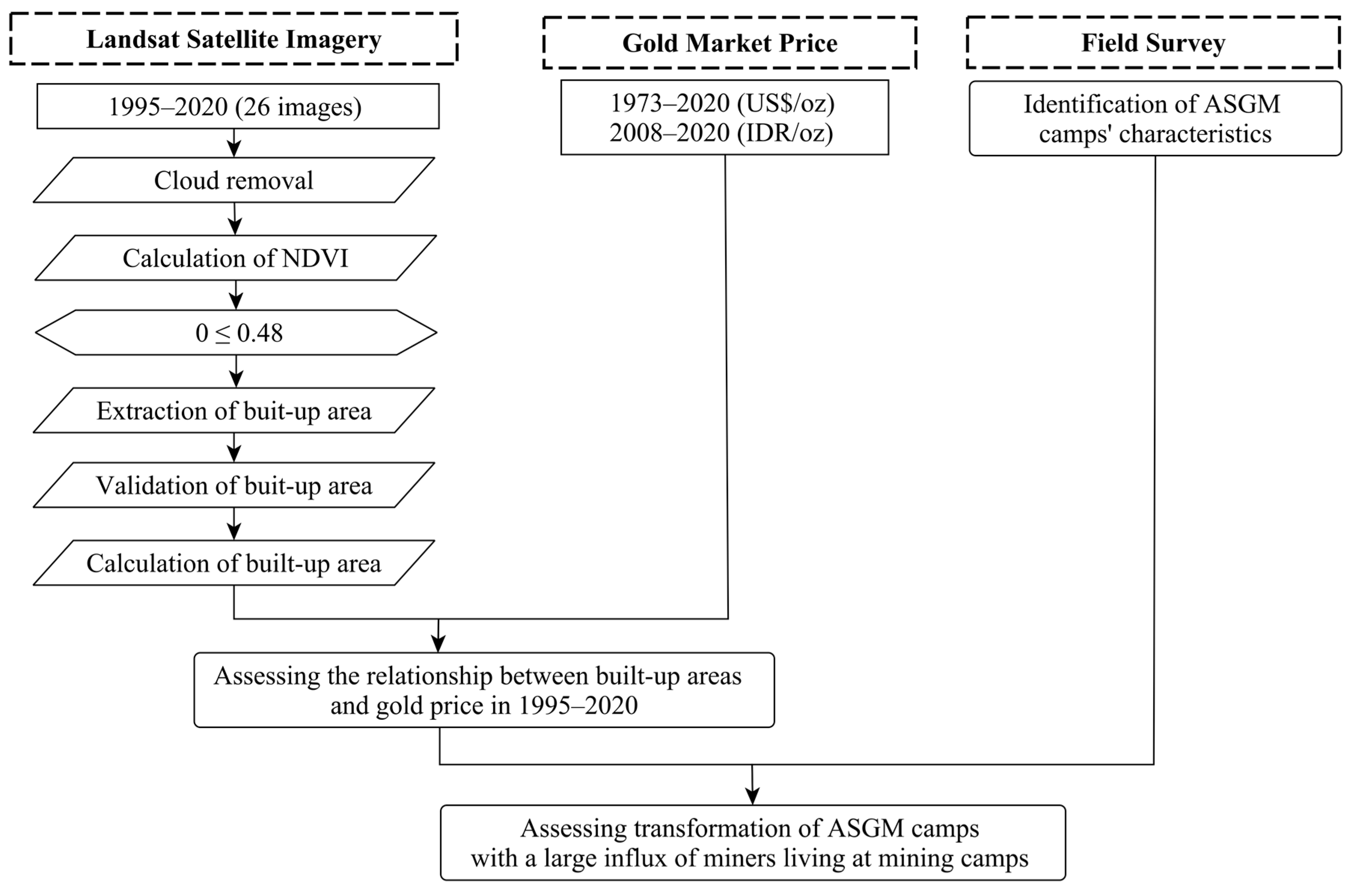
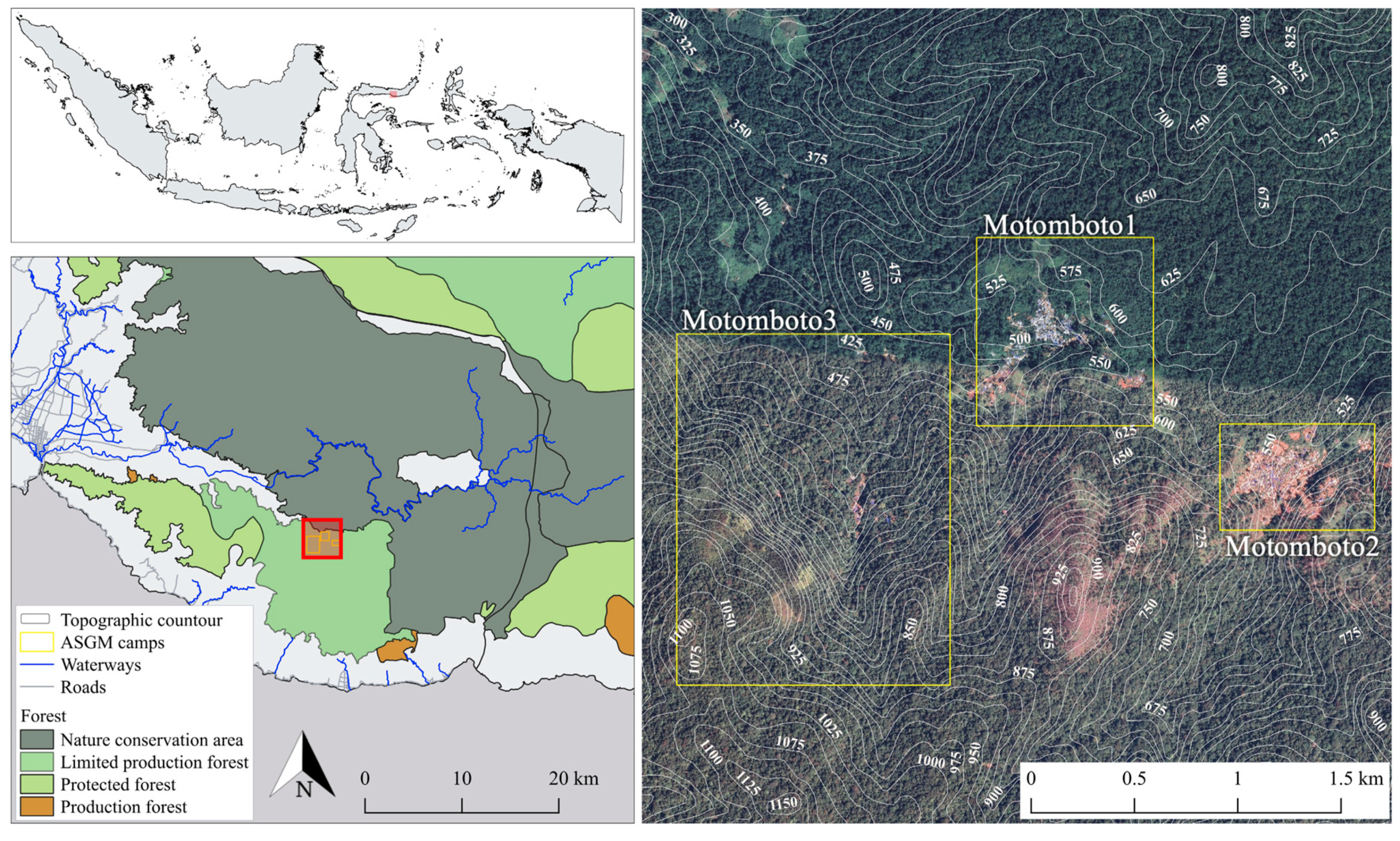
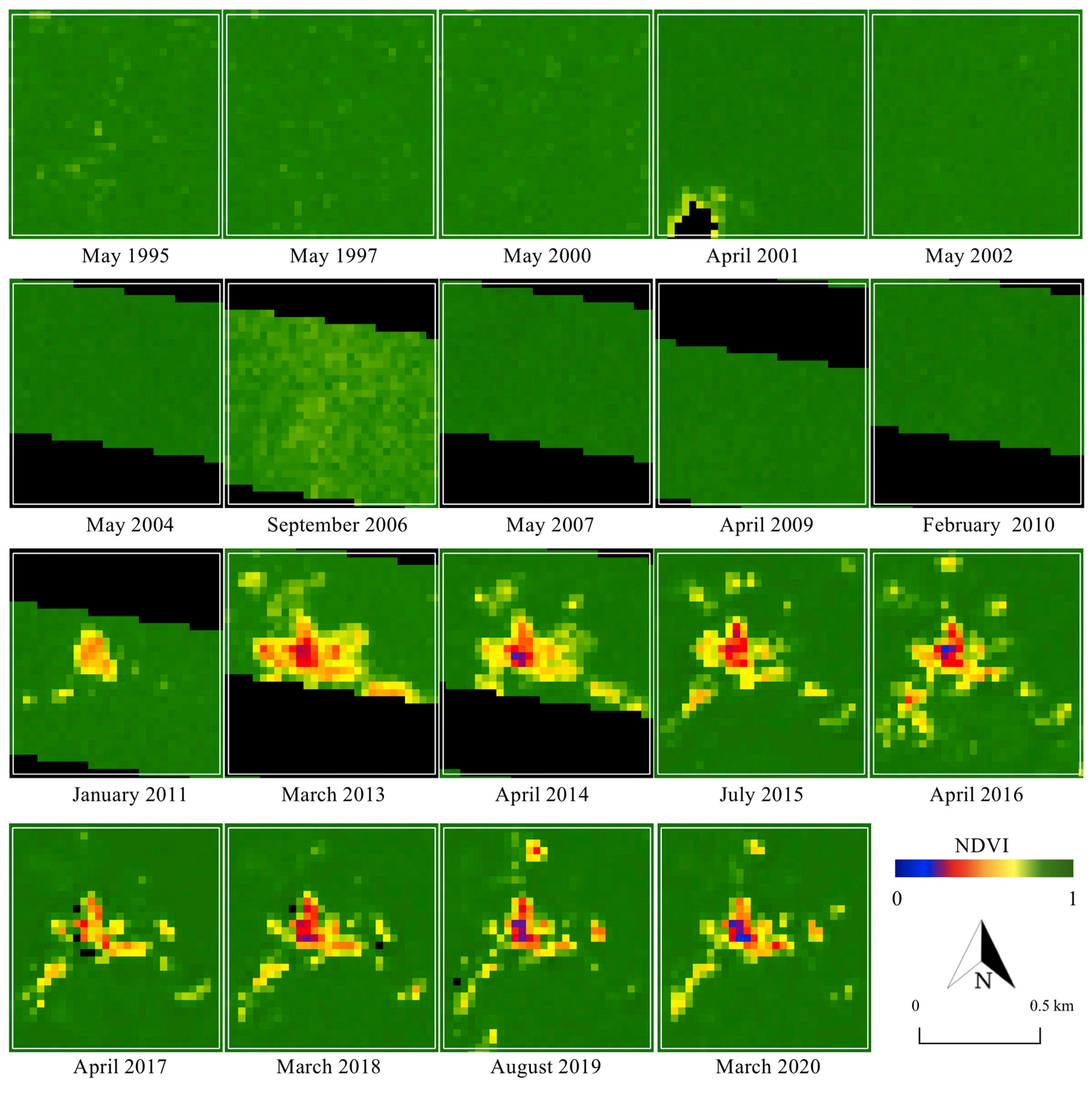

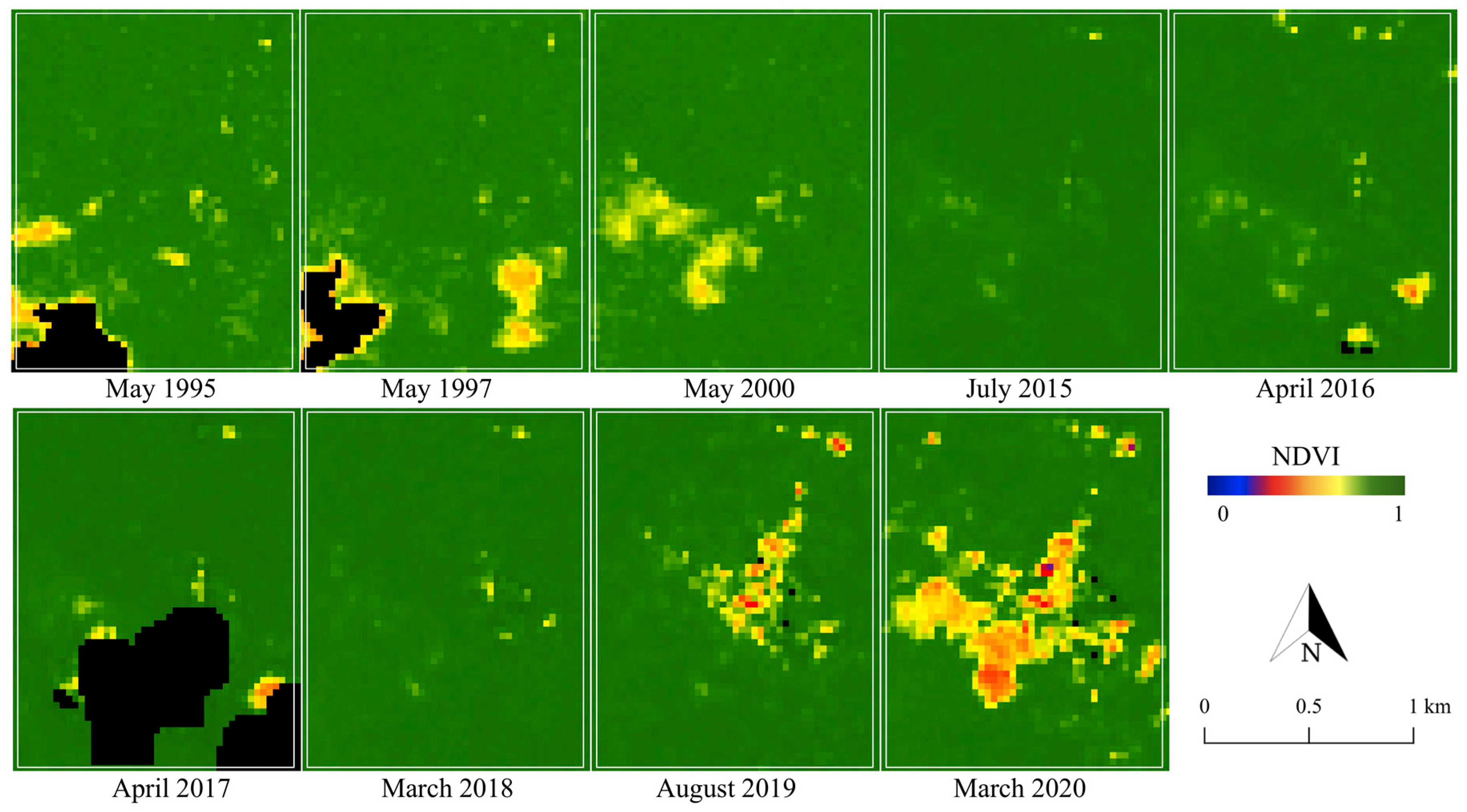
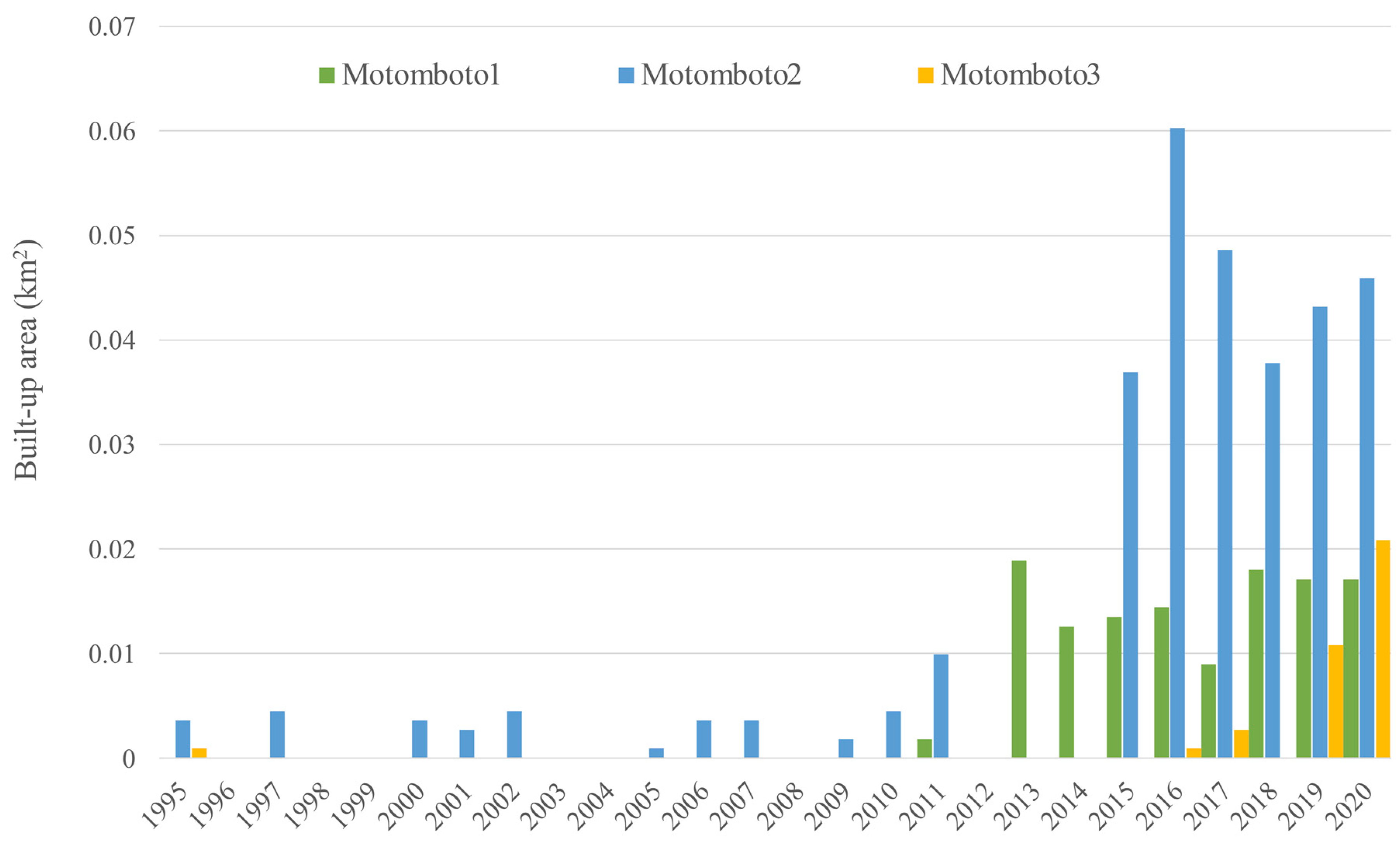
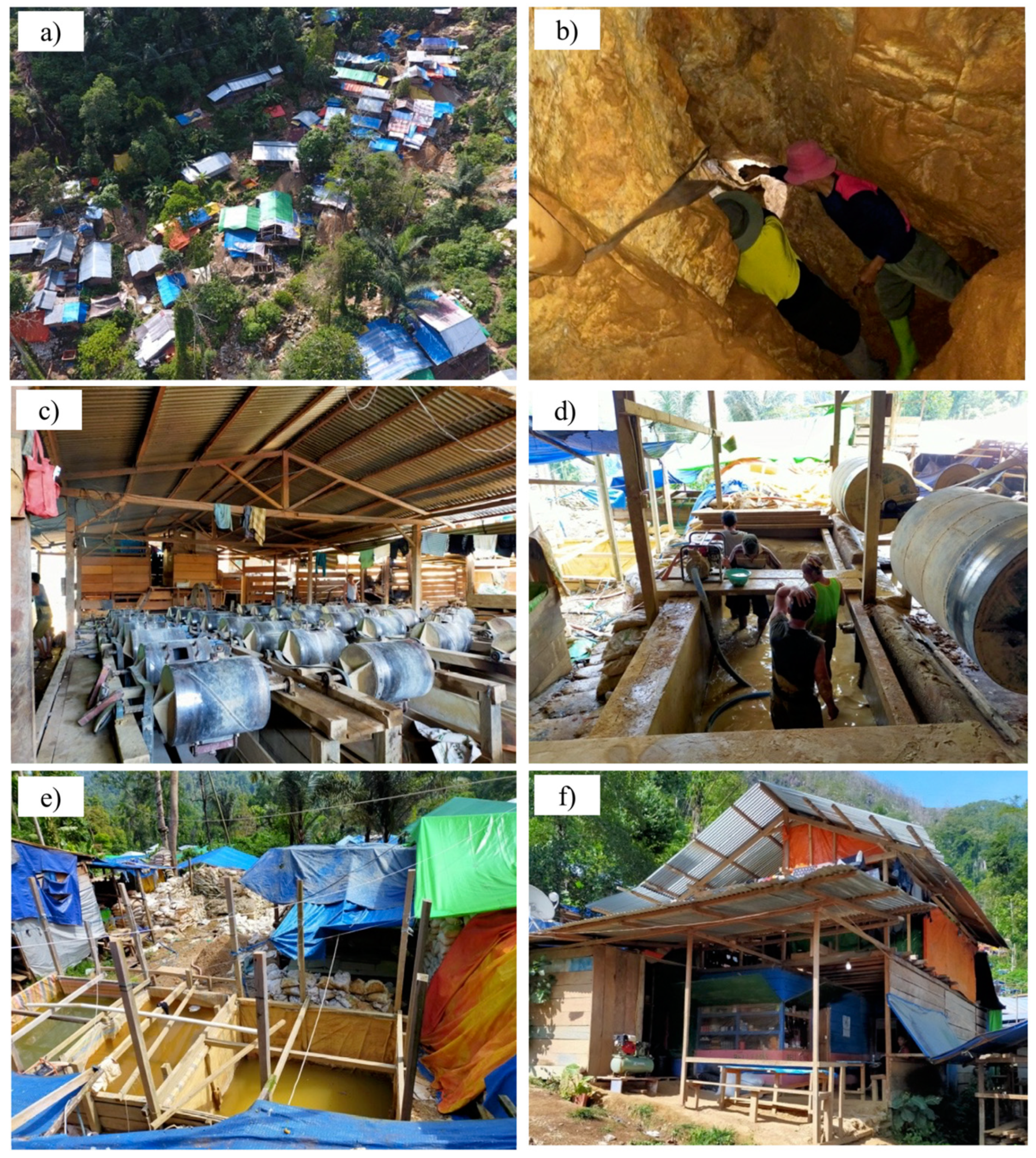
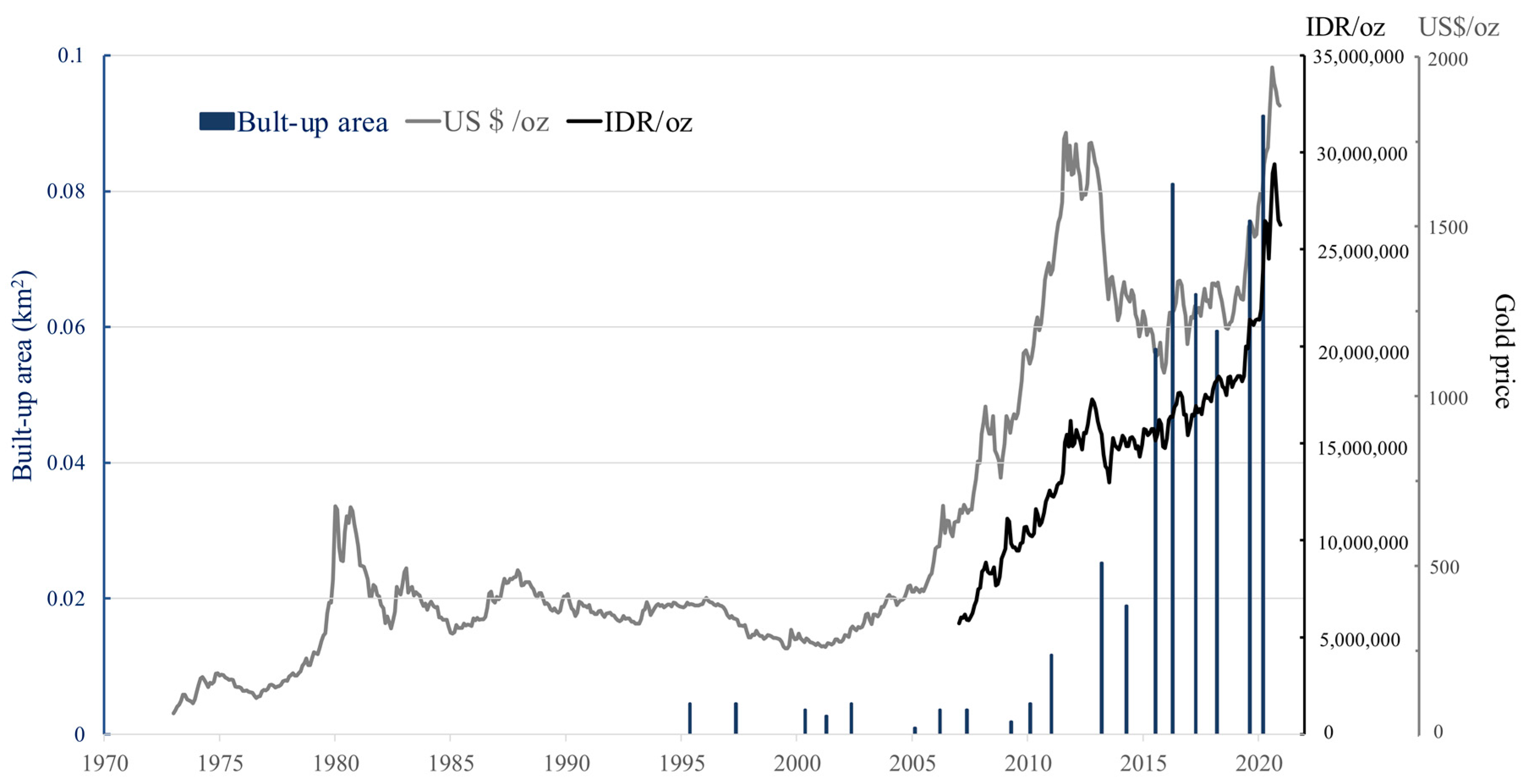
| Acquisition Date | Sensor | NIR (μm) | Red (μm) | Green (μm) |
|---|---|---|---|---|
| 30 May 1995 26 May 1997 11 May 2000 4 April 2001 25 May 2002 | Landsat 5 TM | 0.70–0.80 | 0.60–0.70 | 0.50–0.60 |
| 27 March 2004 10 February 2005 17 March 2006, 25 September 2006 23 May 2007, 30 October 2007 26 April 2009 24 February 2010, 4 September 2010 10 January 2011, 26 November 2011 27 March 2013 24 April 2014 | Landsat 7 ETM+ | 0.76–0.90 | 0.63–0.69 | 0.52–0.60 |
| 8 July 2015 5 April 2016 24 April 2017 10 March 2018 4 August 2019 15 March 2020 | Landsat 8 OLI | 0.85–0.88 | 0.64–0.67 | 0.53–0.59 |
Publisher’s Note: MDPI stays neutral with regard to jurisdictional claims in published maps and institutional affiliations. |
© 2021 by the authors. Licensee MDPI, Basel, Switzerland. This article is an open access article distributed under the terms and conditions of the Creative Commons Attribution (CC BY) license (https://creativecommons.org/licenses/by/4.0/).
Share and Cite
Kimijima, S.; Sakakibara, M.; Nagai, M.; Gafur, N.A. Time-Series Assessment of Camp-Type Artisanal and Small-Scale Gold Mining Sectors with Large Influxes of Miners Using LANDSAT Imagery. Int. J. Environ. Res. Public Health 2021, 18, 9441. https://doi.org/10.3390/ijerph18189441
Kimijima S, Sakakibara M, Nagai M, Gafur NA. Time-Series Assessment of Camp-Type Artisanal and Small-Scale Gold Mining Sectors with Large Influxes of Miners Using LANDSAT Imagery. International Journal of Environmental Research and Public Health. 2021; 18(18):9441. https://doi.org/10.3390/ijerph18189441
Chicago/Turabian StyleKimijima, Satomi, Masayuki Sakakibara, Masahiko Nagai, and Nurfitri Abdul Gafur. 2021. "Time-Series Assessment of Camp-Type Artisanal and Small-Scale Gold Mining Sectors with Large Influxes of Miners Using LANDSAT Imagery" International Journal of Environmental Research and Public Health 18, no. 18: 9441. https://doi.org/10.3390/ijerph18189441






